Abstract
Low-frequency pressure fluctuations are common in open-jet wind tunnels, affecting test accuracy and posing safety risks to the wind tunnels. These oscillations can be caused by different mechanisms in different wind tunnels, and it is often necessary to identify the specific mechanism responsible for the oscillation and develop appropriate control methods. This paper presents a comprehensive review of the current state of research on low-frequency pressure fluctuations in subsonic open-jet wind tunnels, with a particular emphasis on their generation mechanisms and control strategies. The primary source of excitation is attributed to the edgetone feedback formed by the impingement of the jet on the collector. The sound wavelength corresponding to the edgetone frequency is close to that of the plenum scale, facilitating resonance with both plenum-associated vibration modes and specific-order standing wave modes within the circuit loop, resulting in significant low-frequency pulsations. Passive control methods such as nozzle vortex generators and collector breathing gaps have been extensively employed due to their cost-effectiveness and efficiency. The concluding section highlights some unresolved issues that require further investigation in this field.
1. Introduction
1.1. Open Jet Wind Tunnel
A wind tunnel is an aerodynamic testing facility, usually consisting of a series of pipes, which creates a controlled flow of air to simulate the atmospheric conditions experienced by moving objects. Wind tunnels generally consist of a test section, a contraction section, a drive section, a settling chamber, diffusers, and corners (see Figure 1). The test section is the area where aerodynamic measurements are made and is the central component of the wind tunnel. The drive section is responsible for driving the airflow motion and serves as the primary energy source within the wind tunnel. Other components of the wind tunnel are primarily used to regulate and maintain optimal operating conditions for the airflow.
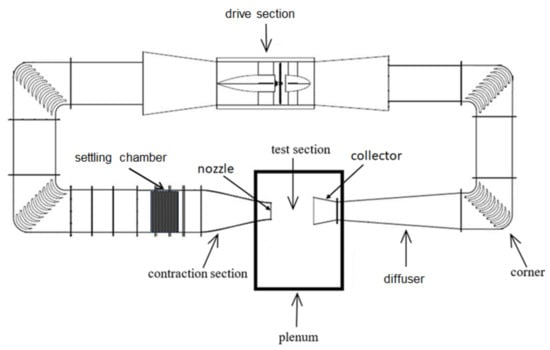
Figure 1.
Schematic of a wind tunnel with an open-jet section.
Depending on the configuration of the test section, wind tunnels can be classified into open-jet wind tunnels and closed wind tunnels [1]. The test section of a closed wind tunnel, together with other sections of the tunnel, forms a continuous closed channel. In contrast, an open-jet wind tunnel creates a free jet in front of the test section and uses uniform airflow within the core region for aerodynamic testing. The airflow from the nozzle is directed through a collector into the first diffuser downstream of the test section, as shown in Figure 1. The test section of an open-jet wind tunnel is typically enclosed by a sealed chamber known as a plenum [1,2,3] or test hall [2,4]. The plenum of an open-jet wind tunnel used for acoustic testing is typically equipped with sound-absorbing wedges on its interior walls and is commonly referred to as either an anechoic plenum or a chamber [2].
Open jet wind tunnels find extensive applications in automotive wind tunnels [5,6,7,8], acoustics wind tunnels [7,9,10,11], and certain specialized wind tunnels [12] due to their low blockage ratio, ease of test model installation and implementation, and large variable angle range of models compared to closed wind tunnels.
1.2. Low-Frequency Pressure Fluctuation in Open-Jet Wind Tunnel
Low-frequency pressure fluctuation is a common phenomenon in open-jet wind tunnels, characterized by periodic low-frequency pressure oscillations within a certain range of test wind speeds [5,8,13,14,15,16]. The acoustic wavelength corresponding to the pulsating frequency is usually close to one order of magnitude of the plenum scale. Sound-absorbing wedges mounted on the plenum walls are unable to effectively eliminate pressure pulsations at this scale.
Researchers commonly refer to this phenomenon as “low-frequency pressure fluctuation” [7,17], “low-frequency pressure oscillation” [9], “low-frequency pressure pulsation” [6,9,11,16,17,18], or “low-frequency pressure surging” [16,17]. The literature often employs terms such as “wind tunnel buffeting” [9], “wind tunnel pumping” [19], “wind tunnel swaying” [11], “vibration of the test hall” [4], “wind tunnel is breathing” [20], or “wind tunnel is undergoing a canning effect” [20] to describe the structural characteristics caused by this phenomenon.
Many large open-jet wind tunnels suffer from low-frequency fluctuations [4,9,16,21,22,23,24,25]. The Langley 4 m × 7 m wind tunnel developed flow pulsations in the open test section configuration that produced static pressure fluctuations, increasing turbulence, and velocity non-uniformity [16,21]. Extensive research has been conducted by researchers at this institution to mitigate these low-frequency pressure fluctuations [16,21]. The low-frequency pressure fluctuations in the large German–Dutch low-speed wind tunnel DNW-LLF with an open test section (8 m × 6 m) directly jeopardized the structural safety of the plenum, and therefore its maximum operating wind speed had to be limited to below 80 m/s [4]. The 3.25 m × 2.8 m low-speed wind tunnel DNW-NWB in Braunschweig, Germany, experienced strong low-frequency pulsations over a wide range of wind speeds, with sound pressure levels as high as 120 dB [9]. The wind tunnel was equipped with Seiferth-wing spoilers on the jet nozzle to reduce the low-frequency pressure fluctuations, but this only reduced the sound pressure level to 93 dB and generated significant high-frequency noise [9]. Significant low-frequency pressure fluctuations were also observed in the open test section of the Large Acoustic Wind Tunnel (LAWT) in China [22,23,24,25]. The specific performance was as follows: once the wind speed exceeded 40 m/s, the pulsation gradually became perceptible to the human ear and there was a discernible vibration in the collector and the control building; at 65 m/s, the vibration intensified and a distinct vibration frequency appeared in the whole test hall and the control building; beyond 75 m/s, the vibration basically disappeared.
Low-frequency pressure fluctuations are also prevalent in automotive wind tunnels, which usually use 3/4-opening jet wind tunnels (square jets, and one side of the jet is at ground level, while the other three sides are free jet surfaces) [5,7,8,13,14,15,26,27]. The S2A automotive wind tunnel located in Montigny-le-Bretonne, France, identified four distinct oscillation zones within the wind speed range of 10 m/s to 60 m/s. At a wind speed of 16.7 m/s, the pressure pulsation frequency outside the jet was close to 1.6 Hz, with an amplitude of nearly 100 dB, accompanied by a velocity pulsation of nearly 3% in the core of the jet [8]. The initial operation of the Hyundai Motor Aeroacoustic Wind Tunnel (HAWT) in South Korea revealed significant static pressure fluctuations over most wind speed ranges [7]. The use of vortex generators effectively mitigated pressure pulsations, but inadvertently resulted in an increased background noise level within the test section and an excessive static pressure gradient ahead of the collector, exceeding the design specifications of the wind tunnel. Researchers have conducted extensive theoretical research and wind tunnel testing to determine an optimal solution [7].
Low-frequency pressure fluctuations can pose a number of hazards to open-jet wind tunnels. The pressure pulsations cause a poor quality of the flow field in the jet region, thereby affecting the stability of both velocity and pressure within the wind tunnel. Consequently, this leads to a reduction in measurement accuracy [16,22]. The infrasonic waves generated by low-frequency pressure fluctuations in the test environment may pose health risks to the participants. The vibration of the wind tunnel structure may cause vibration fatigue of the test equipment and compromise test safety. Strong low-frequency pressure fluctuations may even cause vibrations in the wind tunnel structure, thus endangering the safety of the wind tunnel building [4,5,26]. In addition, the vibrations in the flow field and structure lead to energy dissipation. Therefore, attenuating or suppressing these low-frequency pressure fluctuations is of positive significance for improving measurement accuracy and enhancing energy utilization efficiency and safety in open-jet wind tunnels, as well as creating a better working environment for testers.
It should be remarked that the primary focus of this paper is to investigate the mechanisms and control methods associated with wind tunnel design and enhancement, without delving into the intricate flow physics of low-frequency pressure pulsation. The paper is primarily concerned with the low-frequency pressure fluctuations observed in subsonic open-jet wind tunnels, not taking into account transonic and supersonic wind tunnels where shock waves introduce a different scenario. In addition, this review is based on an extensive analysis of existing literature conducted by the authors. While striving for objectivity throughout the analytical process, it is inevitable that subjective opinions become intertwined.
The paper is organized as follows: Section 2 provides a comprehensive overview of the mechanism underlying low-frequency pressure fluctuations, including the sources of excitation and resonance mechanisms. Section 3 examines various methods for low-frequency pressure fluctuation suppression. Lastly, Section 4 presents concluding remarks.
2. Mechanism of Low-Frequency Pressure Fluctuation
The origin of low-frequency pressure fluctuations in open-jet wind tunnels is not yet fully understood. The low-frequency pressure fluctuations involve several factors, including the structural modes of the wind tunnel, instability of the jet shear layer, fluid-structure interaction, vortex-acoustic interaction, and acoustic propagation. The phenomenon of low-frequency pressure fluctuations in different wind tunnels often involves different excitation mechanisms, which poses challenges to the theoretical prediction and design of control methods [5,8,16,26,28,29,30,31,32].
The excitation source and the resonance mechanism are the two primary factors responsible for the generation of significant low-frequency pressure fluctuations in open-jet wind tunnels. The excitation source derives energy from the wind tunnel airflow and generates the pulsations, while the excitation mechanism amplifies certain pulsation modes into significant low-frequency pressure fluctuations.
2.1. Excitation Source of Low-Frequency Pressure Fluctuation
The primary source of excitation for low-frequency pressure fluctuations in open-jet wind tunnels is the feedback loop resulting from the interaction between the jet and the collector [5,8,16,26,30,31], commonly referred to in the literature as edgetone. As the jet shear layer progresses downstream, large-scale vortex structures are generated as a result of the Kelvin–Helmholtz instability [33]. These vortex structures interact with the collector, resulting in outward-radiating pressure waves. The upstream propagation of these pressure waves induces further effects on the shear layer, leading to the formation of a self-sustaining oscillation loop known as edgetone feedback. Once established, this edgetone feedback becomes the dominant mode of low-frequency oscillations in the shear layer.
The phenomenon of edgetone feedback is commonly observed in open-jet wind tunnels. When intrinsic modes in the wind tunnel structure have frequencies close to it, edgetone feedback can produce significant low-frequency pressure fluctuations by resonance, as it directly harnesses energy from the jet.
In the edgetone loop of an open-jet wind tunnel, the pressure wave can propagate upwards, either through the interior of the jet at a velocity of , where a is the speed of sound and U is the jet velocity, or through its exterior at a velocity of a [20]. The edgetone loop formed by the inner path can be called internal feedback, while the edgetone loop formed by the outer path can be called external feedback. There is a certain difference in the frequency of these two feedback loops, and which one plays a dominant role depends on the configuration and flow conditions of the specific wind tunnel.
The edgetone phenomenon is not unique to the jet impingement problem. In fact, edgetone feedback is commonly observed in various scenarios involving the interaction between shear layers and solid structures [28,29], such as subsonic and supersonic flows with open cavities [34], adjacent tall buildings, and hydraulic system valves.
The edgetone phenomenon was first documented by Sondhaus in 1854 [28]. In 1979, Rockwell provided a comprehensive review of contemporary research on shear-layer impingement configurations [28]. He identified two key conditions for the self-sustaining oscillation phenomenon in shear-layer impingement systems: instability of the shear-layer and feedback formed by upstream disturbance propagation. Rockwell believed that the primary cause of edgetone feedback was shear-layer instability.
The majority of experimental investigations on edgetone have used flow-field visualization in conjunction with velocity and pressure measurements [28,35,36,37,38,39,40,41]. Researchers generally characterize the propagation of upstream disturbances as either an acoustic or a hydrodynamic phenomenon [28,35,36,37,38,39].
Powell [36], Curle [42,43], Nyborg [44], and others have proposed formulas for predicting the frequency of edgetone in terms of the jet length, jet velocity, etc. Rennie [6], based on the above works, developed the following formula for predicting the frequency of edgetone in open-jet wind tunnels:
where represents the velocity of the downstream vortex transfer and is the velocity of the feedback pressure wave propagating upstream. For external feedback, , while for internal feedback, , where U is the jet velocity and a is the speed of sound. is defined as the distance from the nozzle to the collector with an uncertainty measure, , and the number of large-scale vortex pairs contained between the nozzle and the collector is denoted by n.
Zhang et al. [22,24] subsequently modified Equation (1) as follows:
In 1964, Rossiter proposed a formula for the prediction of the frequency of edgetone in open cavities [30]:
where and K are constants and is the Mach number. For external feedback, it is easy to see that Equation (2) can be obtained from Equation (3) by setting and replacing the role of with the uncertainty measure .
Brown [45], Brackenridge [38], Powell [36], and others have observed a “ladder-like” behavior of the edgetone frequency, wherein as the distance between the nozzle and the collector or the velocity of the jet is gradually increased, there is a continuous change in the oscillation frequency, but beyond a certain threshold there is an abrupt transition to another “stage” of frequency [28,29]. The different stages correspond to different oscillation modes, which are denoted by the number n in Equations (2) and (3). It has been found that various types of edgetone feedback exhibit this mode-jumping phenomenon [28,30,35].
The estimation of the amplitude of edgetone is also a concern of researchers [46,47]. The experimental findings of Stegen and Karamcheti [46] indicated that the amplitude of the edgetone was influenced by several factors, including incoming flow conditions and jet length. Holger et al. [47] used a potential flow model to estimate the force exerted by low-velocity jets (below 20 m/s) on the edge and predict the far-field sound pressure distribution based on Lighthill’s sound analogy theory [48]. Their theoretical predictions were in good agreement with their experimental results as well as Powell’s sound-field test results [36].
2.2. Resonance Mechanism of Low-Frequency Pressure Fluctuation
Rossiter [30] postulated that periodic pressure pulsations in cavities result from acoustic resonances excited by edgetone feedback, and this theory has been applied by several researchers to investigate low-frequency pressure fluctuations in open-jet wind tunnels. It is generally accepted that significant low-frequency pressure fluctuations occur when the edgetone feedback frequency matches the natural frequency of some part of the wind tunnel structure [4,6,17,18,20,26].
The frequency of the edgetone is determined by both the length and the velocity of the jet. Since the jet length and plenum dimensions are usually comparable in magnitude, the edgetone feedback frequency is likely to be close to the vibration frequencies associated with the plenum, as well as certain frequencies of standing waves within the pipe loop. As a result, resonance occurs, resulting in significant low-frequency pressure fluctuations.
Different wind tunnels may have different resonance excitation mechanisms. The potential excitation sources that can resonate with edgetone feedback include the standing wave modes of the wind tunnel circuit [4,6,7,8,9,11,19,26], the reverberation modes of wind tunnel chambers [4,6,19,26], the Helmholtz modes of wind tunnel chambers [6,8,26], and the pressure pulsation modes caused by the rotation of the wind tunnel fans [4]. Planar standing waves in the three directions of the plenum also serve as excitation sources for low-frequency pressure fluctuations in open-jet wind tunnels [22,23,25,49].
Edgetone feedback easily excites the standing wave modes of the wind tunnel circuit and the Helmholtz mode of the plenum, as confirmed by several studies [4,6,7,8,9,19,26]. The pressure pulsation generated by the rotation of the fan, on the other hand, does not easily resonate with the edgetone feedback due to its high frequency. The occurrence of a standing wave in the plenum is related to the ratio of plenum size to jet length [22].
Table 1 provides an overview of the primary resonance mechanisms found in various wind tunnels as documented in the literature, along with the corresponding techniques for suppression. It can be seen that the standing wave of circuit loop is the most prevalent source of excitation.

Table 1.
Summary of fluctuations according to resonance mechanism and wind tunnels.
In the IVK-MWT wind tunnel, three modes share a common frequency of 18 Hz: the edgetone feedback mode, the 5th order wind tunnel circuit loop mode, and the plenum longitudinal standing wave mode. The edgetone feedback mode is the only mode that involves energy injection, while the other two are passive modes without injection. Note that in Table 1, the author infers that the plenum planar standing wave of IVK-MWT and DNW-LLF wind tunnels serves as an excitation source that resonates with edgetone feedback. This inference is made based on literature data and is detailed in the fourth part of Section 2.2.2.
2.2.1. Circuit and Helmholtz-Type Resonance
Rennie et al. [7] presented a study on the suppression of low-frequency pressure fluctuations in the HAWT wind tunnel in South Korea. The results demonstrated excellent agreement between the measured frequency of the low-frequency pressure fluctuation and the theoretically calculated frequency of the circuit acoustic mode of a certain order, indicating that one of the modes within the wind tunnel circuit is responsible for exciting the low-frequency pressure fluctuations.
The study conducted by Wickern et al. [26] identified three dominant frequencies in a 1:20-scale wind tunnel of the Audi Aeroacoustic Wind Tunnel (AAWT). Two of these frequencies were attributed to the circuit modes of the wind tunnel, while the third frequency corresponded to the Helmholtz frequency of the plenum. In contrast, three circuit modes were observed in the full-scale AAWT, two of which corresponded to those found in the scaled wind tunnel.
The study conducted by Hu et al. [50] also revealed that the edgetone feedback resonated with one of the modes presented in the pipeline circuit of the Jilin University open-jet wind tunnel.
2.2.2. Planar Standing Wave in Plenum
- Plenum standing wave as an excitation source in LAWT
Recently, Jin et al. [22] discovered that the significant low-frequency pressure fluctuation in the plenum of the LAWT manifests itself as a planar pressure standing wave in the transverse direction, the amplitude of which can be expressed as:
where A denotes the pressure maximum, y is the width-direction coordinate (the plenum is symmetric about the jet center in the transverse direction), is the wavelength, is the width of the plenum, f is the frequency of the standing wave, and t is the time.
A diagram illustrating the pressure standing wave is presented in Figure 2. It can be seen that the waveform has a sinusoidal pattern with an anti-symmetric distribution along the y-axis.
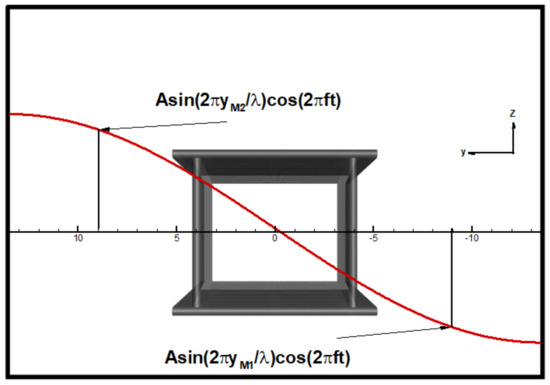
Figure 2.
Schematic of the pressure standing wave in the plenum of LAWT, as viewed from the collector towards the nozzle. Note that corresponds to the negative value of . Originally shown in [22].
- Mechanism and prediction of plenum standing wave
It was found that the planar pressure standing wave resonated with the edgetone feedback, resulting in significant low-frequency pressure fluctuations in the LAWT [22]. On the basis of this, the condition for the maximization of the low-frequency pressure fluctuation caused by the standing wave can be derived as follows [22]:
where denotes the width of the plenum, is the jet Mach number, and the definitions of the remaining symbols correspond to those in Equation (1). Equation (5) was derived in the literature [22] by making the edgetone frequency given by Equation (2) equal to the standing wave frequency in the transverse direction of the plenum:
Note that the contribution of is not considered in Equation (5). In the literature [22], only the external feedback is considered, resulting in , and the number of modes, n, is taken as the number of large vortex pairs in the jet (), under the operating conditions of the LAWT wind tunnel. When the discrepancy between and the predicted value of Equation (5) falls below 20%, the resonance of the standing wave with edgetone feedback is likely to occur.
The large-scale vortices on both sides of the jet can exhibit either symmetric or antisymmetric patterns. Jin et al. [22] noted that the resonance between the standing wave and edgetone feedback strengthens the antisymmetric vortex mode. As a result, the antisymmetric vortex mode dominates the edgetone feedback and serves as an energy source for the width-direction standing wave, as illustrated in Figure 3.
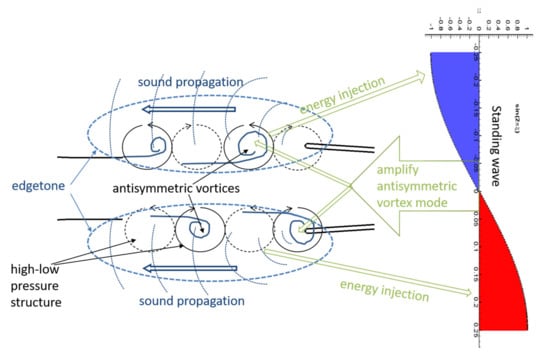
Figure 3.
Schematic of the interaction of the transverse standing wave with the antisymmetric vortex mode. Originally shown in [22].
Due to the antisymmetric characteristics of the standing wave, its amplitude approaches zero at the center of the jet and increases as it moves away from the center (as depicted in Figure 2). Hence, the pressure standing wave is more prone to interact with the external feedback loop of edgetone feedback. Consequently, when resonance between the edgetone feedback and the standing wave occurs, its frequency aligns closer to that of the external feedback loop rather than internal feedback [22].
- Planar standing wave in SKLA-01
After discovering widthwise planar standing waves as a resonant excitation source for LAWT wind tunnels, Jin et al. built a 1:20-scale LAWT wind tunnel (SKLA-01) with a width-adjustable plenum.Their results revealed the presence of planar pressure standing waves in all three directions of the plenum; however, these standing waves were comparatively weaker in the other two directions compared to the width direction [25,49]. The analysis by Jin et al. [25,49] showed that the standing wave frequency in the vertical direction of the plenum is close to that of a circuit standing wave mode in the wind tunnel. Since there was no direct energy injection into these two standing wave modes, Jin et al. [25,49] speculated that these two modes appeared because they satisfied the resonance condition, which led to self-excited oscillations through the resonance mechanism between them by capturing energy from the airflow.
Jin et al. [25,49] did not provide any information about the excitation source for the longitudinal standing wave of the plenum. Considering that the length () and width () of the plenum were quite close (), so that the longitudinal standing wave mode also satisfied the resonance condition with the edgetone, the authors of this paper speculate that the longitudinal standing wave may also have developed in the process of resonance with the edgetone feedback. The reason why the pulsation intensity of the longitudinal standing wave was lower than that of the transverse standing wave may be due to the lack of antisymmetric modes in the shear layer as an energy transfer intermediary for the longitudinal standing wave.
Jin et al. [25,49] found that the addition of a floor to the plenum of the SKLA-01 wind tunnel (as shown in Figure 4) significantly enhanced the widthwise standing wave mode. The underlying cause of this phenomenon remains unclear, and Jin et al. [49] hypothesized that it may be because the pressure above the floor is lower than that below during wind tunnel operation, resulting in the formation of vortex pairs similar to wingtip vortices on either side of the floor. The relative strengths of these two vortices alternated under the influence of the anti-symmetrically distributed standing wave, which in turn enhanced the widthwise pressure standing wave.
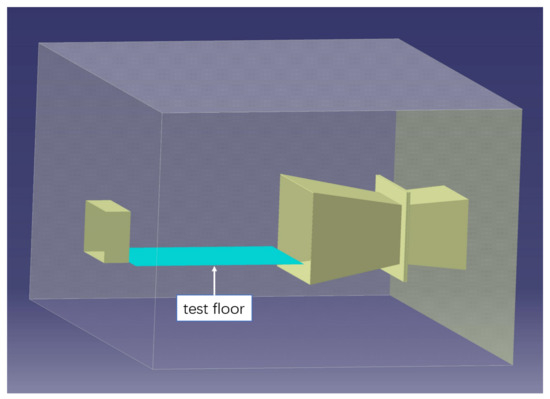
Figure 4.
Schematic of an open-jet wind tunnel with floor.
- Other cases of resonance between plenum standing wave and edgetone
Although it has not been reported until recently [22], the probability of resonance between the planar standing wave modes in the three directions of the plenum and the edgetone feedback is quite high. For example, at Mach number = 0.2, Equation (5) suggests that if the size of the plenum in one direction is approximately twice that of the jet (within 20% deviation), resonance can occur between the edgetone and the standing wave in that direction.
In the literature [19], von Heesen et al. reported the existence of standing waves in three directions of the plenum in the IVK 1:4-scale Model Wind Tunnel in Stuttgart (IVK-MWT). To the best of the authors’ knowledge, this is the first report of standing waves in the plenum of an open-jet wind tunnel. Due to a lack of confidence in the edgetone feedback model of von Heesen et al., their paper [19] did not investigate the possibility of planar standing waves resonating with edgetone feedback. Here, we calculated the conditions under which standing waves resonate with edgetone feedback in the three directions of the plenum for the IVK-MWT wind tunnel using Equation (5), as shown in Table 2.

Table 2.
The conditions of standing waves resonating with edgetone feedback in IVK-MWT.
In Table 2, the discrepancy between the actual values of in the three plenum directions and the predicted values from Equation (5) were computed as:
In Table 2, it can be seen that the discrepancy in all three directions is less than 15%. As mentioned above, the resonance of the standing wave with edgetone feedback is likely to occur when the discrepancy falls below 20%. Therefore, it can be inferred that the standing waves in each of the three directions of the plenum of the IVK-MWT wind tunnel (at different wind speed ranges) resonate with edgetone feedback. Additionally, it can also be seen that a smaller discrepancy results in larger amplitude oscillations of the standing waves.
It should be noted that, in Table 2, the wind speed when the Z-direction standing wave is the strongest is given according to the maximum operating speed of the wind tunnel, which is 77.8 m/s. If the maximum operating wind speed of the wind tunnel can be increased to obtain the real wind speed when the Z-direction standing wave reaches the strongest, the Z-direction discrepancy given in Table 2 might be reduced to the same order as that in the X- and Y-directions.
Another possible example of edgetone feedback resonating with a plenum planar standing wave can be observed in the DNW-LLF wind tunnel. As previously noted, due to the low-frequency pressure fluctuations posing a safety risk to the wind tunnel, DNW-LLF had to impose a maximum wind speed limit of less than 80 m/s for its open test section.
According to the literature [4], the open test section of DNW-LLF has a jet length of 18.7 m and a plenum width of 28.2 m. Assuming the speed of sound is 340 m/s, we can calculate the frequency of the standing wave in the width direction utilizing Equation (6) to be Hz.
Figure 5 displays the relationship between the edgetone frequency and wind speed according to Equation (2) with external feedback, , and . When the wind speed reaches approximately 80 m/s, the frequency of external edgetone feedback reaches just , indicating entry into the resonance region. These results are consistent with test runs performed in this wind tunnel, where wind speeds approaching 84 m/s caused roof damage, necessitating wind speeds to be limited to below 80 m/s [4]. Therefore, it is highly probable that significant low-frequency pressure fluctuations in DNW-LLF’s open test section are also caused by resonance between edgetone feedback and width-direction planar standing wave in the plenum. In addition, the findings from Figure 5 indicate that low-frequency pressure oscillations in the wind tunnel will likely reach their maximum amplitude at a wind speed of approximately 104 m/s.
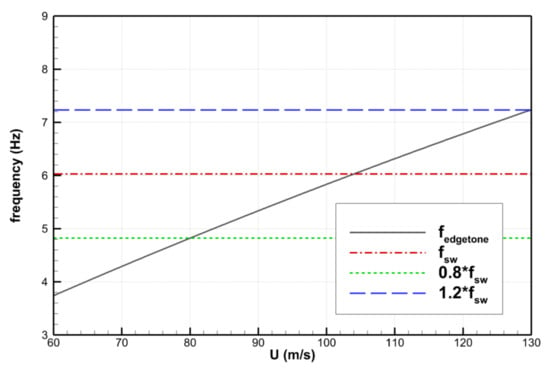
Figure 5.
Variation of the edgetone frequency with wind speed in DNW-LLF open test section.
3. Suppression Methods for Low-Frequency Pressure Fluctuation
Suppression measures for low-frequency pressure fluctuations can be categorized into passive and active control. Active control methods require changing the flow state by injecting mass or energy according to the specific flow situation, while passive control methods do not require mass or energy injection.
Commonly used passive control measures include (i) the incorporation of a vortex generator at the jet nozzle [2,3,4,8,9,16,23,49,51,52,53,54,55], (ii) optimization of the configuration of the collector, which includes shape optimization [4,6,17,21,23,31,49,56,57] and the addition of a breathing gap [4,6,7,14,15,21,58,59], (iii) the introduction of resonant chambers (Helmholtz resonators) connected to the plenum or the wind tunnel circuits [31,55,60], and (iv) modifying the wind tunnel circuits [9,11,19].
The active control techniques commonly employed include the utilization of loudspeakers and nozzle-activated flaps [19,26,27,32,50].
The commonly used low-frequency pressure suppression methods described in the literature are summarized in Table 3. Each method is assessed based on its effectiveness, side effects, cost, and application range. Their performance is rated with −, 0, +, and to indicate poor, fair, good, and better results, respectively.

Table 3.
Summary of suppression methods .
It can be observed that both the collector breathing gap and the nozzle vortex generator exhibit favorable characteristics across multiple aspects and are widely employed as control strategies in practical wind tunnel applications (refer to Table 1).
3.1. Vortex Generators
The incorporation of various vortex generators at the nozzle of an open-jet wind tunnel is a widely used passive control method for mitigating low-frequency pressure fluctuations [3,16,23,49,51,52,53,61].
The jet nozzle is located at the initial stage of the jet shear layer development, where even small perturbations introduced into the jet can have a significant effect on its downstream evolution. Therefore, this location is considered optimal for controlling the jet. Conventional vortex generators installed in the jet nozzle modify both the frequency and intensity of the edgetone feedback by introducing small-scale vortices into the jet shear layer, thereby enhancing mixing within the jet shear layer and altering the pattern of the downstream large-scale vortices.
Nozzle-vortex-generators are a cost-effective and straightforward solution. However, the small-scale vortices produced by them contribute to high-frequency noise levels [2,23,53,62].
3.1.1. Two-Dimensional Vortex Generators
The first vortex generators used to suppress low-frequency pressure fluctuations in open-jet wind tunnels were primarily two-dimensional sheet-like spoilers, commonly referred to in the literature as vanes, tabs, or teeth, etc. [16,63].
Figure 6 is a typical sheet-like vortex generator called a Seiferth-wing, which is characterized by rectangular sheets with two different angles of inclination to induce disturbances [16]. According to Seiferth [16], these spoilers promote intense mixing within the jet shear layer, thereby dispersing the vortex rings and preventing their simultaneous impact on the collector. Implemented in the DNW-NWB low-speed wind tunnel in Braunschweig, Germany, Seiferth-wings successfully mitigated low-frequency oscillations; however, due to their generation of broadband noise, they were abandoned when the wind tunnel underwent acoustic modifications in 2009 [2].
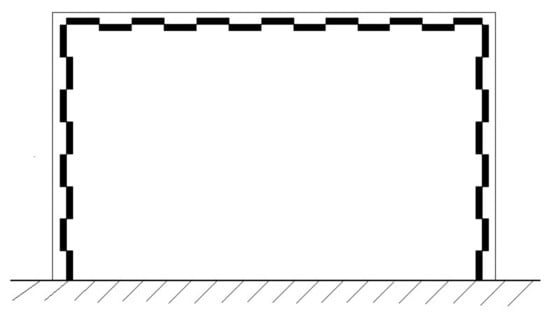
Figure 6.
Schematic of Seiferth-wings on wind tunnel nozzle.
Researchers at NASA Langley Research Center designed six different configurations of nozzle spoilers for a 4 m × 7 m open-jet wind tunnel [16] and used hot-wire anemometers to measure velocity pulsations at the jet center to assess their effectiveness in mitigating flow pulsations. The results showed that the alternating arrangement of triangular spoilers had superior effectiveness, as shown in Figure 7.
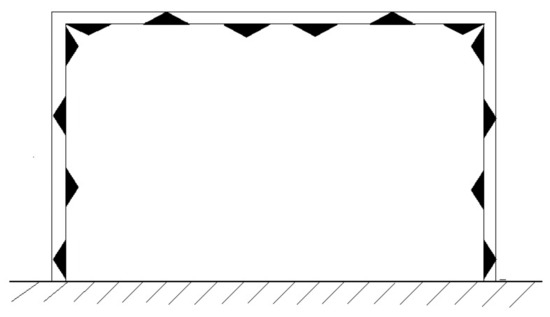
Figure 7.
Schematic of triangular vanes on wind tunnel nozzle.
The French S2A automotive wind tunnel used a system of two rectangular flaps with a small plunging angle, installed at the upper edge of the nozzle exit (see Figure 8). This solution had less intrusion into the jet than classical vortex generators, resulting in improved flow-field quality and reduced flow noise [8].
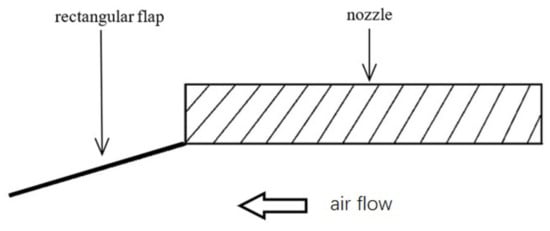
Figure 8.
Schematic of passive rectangular flaps for the S2A wind tunnel nozzle.
Hu et al. [50] investigated rectangular spoilers that protruded from and were aligned parallel to the nozzle wall. According to numerical simulations, using vortex generators was effective in reducing velocity pulsations and low-frequency pressure fluctuations.
3.1.2. Three-Dimensional Vortex Generators
Three-dimensional vortex generators generate lower levels of high-frequency noise in comparison to two-dimensional spoilers.
Tetrahedral vortex generators were used in the 8 m × 6 m open-jet test section of the German–Dutch Wind Tunnel DNW-LLF [4]. This innovative solution effectively reduced plenum vibrations while increasing jet velocity by 6% (at the same motor speed) without a significant impact on background noise levels.
The Institute of Automotive Engineering and Vehicle Engines Stuttgart (FKFS) in Germany has developed a streamlined vortex generator called FKFS besst, shown in Figure 9. The generator has a rectangular shape, with a convex upper surface and a lower surface that adheres to the inner wall of the nozzle. In addition, it is equipped with concave chambers on both sides. In 2014, the FKFS besst was successfully implemented in an automotive wind tunnel for aero-acoustic studies [54,55], where it was uniformly positioned along the left, right, and upper walls of the jet nozzle.

Figure 9.
Schematic of the three-dimensional vortex generator FKFA besst.
3.1.3. Corner Vortex Generator
Jin et al. [23,49] recently discovered that the placement of vortex generators at the corners of the rectangular nozzle in the LAWT wind tunnel effectively suppressed low-frequency pressure fluctuations. In contrast, placing vortex generators at the center of the inner wall of the rectangular nozzle increased the low-frequency pressure fluctuations. In response to these findings, Jin et al. [23,49] designed a corner vortex generator (CVG) with a circular upper surface and a flat rectangular lower surface (shown in Figure 10 and Figure 11), which was able to control the root-mean-square (RMS) level of low-frequency pressure fluctuations in the test section of the LAWT wind tunnel to less than 0.4% and maintain favorable acoustic characteristics [23].
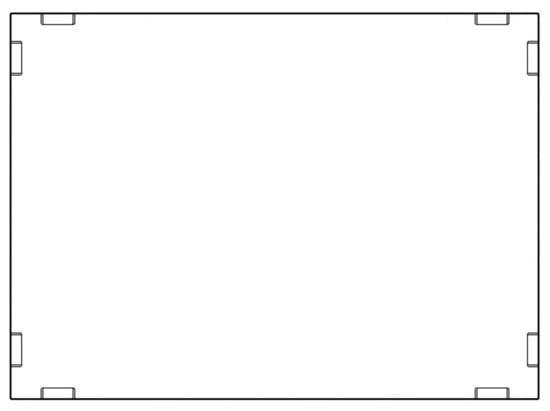
Figure 10.
Schematic of CVG installation location.
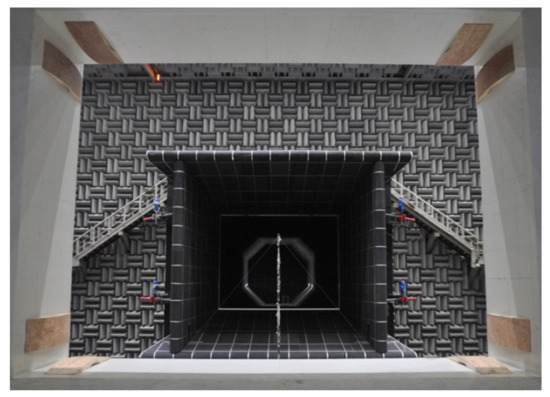
Figure 11.
CVG mounted on the LAWT nozzle.
By using numerical simulations, Jin [49] found that the vortices generated by the CVG at the corners of the square jet have a pumping effect on the turbulence at the lateral centers of the jet. As a consequence, the jet expansion angle decreased, enabling the collector to wrap more effectively, as shown in Figure 12. As will be discussed in Section 3.2.2 of this paper, increasing the inlet size of the collector can effectively mitigate the impact of the transverse standing wave. The oscillation caused by the width-direction standing wave of the plenum was suppressed by reducing the jet expansion angle, which is equivalent to widening the collector inlet.
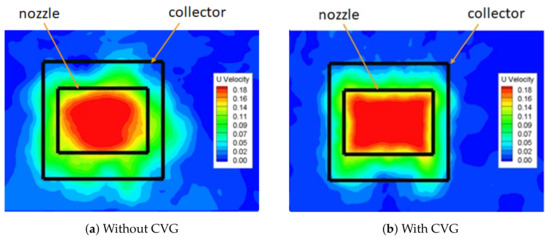
Figure 12.
The velocity contours at the inlet cross-section of the collector, both with and without CVG, are shown using the velocity divided by the speed of sound at the center of the nozzle. Originally shown in [49].
The function of the CVG is not to increase the stability of the shear layer by introducing small-scale vortices into the jet shear layer, as traditional vortex generators do, but rather to regulate the jet expansion angle through the suction effect of corner vortices on turbulence in the lateral center of the jet. Consequently, the effect of the CVG and traditional nozzle vortex generators on jets is the opposite: while traditional vortex generators promote the development of turbulence in the jet shear layer, thereby increasing its expansion angle, the CVG reduces this angle by drawing turbulence toward the corners. Keeping this in mind, it is clear why Jin et al. [23,49] witnessed amplified low-frequency pressure fluctuations by adding vortex generators at the center of the inner wall of the rectangular nozzle.
3.2. Collector Optimization
The collector, as a component that directly interacts with the jet, is an important link in the formation of the edgetone feedback loop. Optimizing the configuration of the collector can effectively reduce the fluctuations caused by the jet impingement of the collector and reduce the contribution of the jet-collector interaction to the edgetone feedback, thereby suppressing the low-frequency pressure fluctuations in the plenum.
3.2.1. Breathing Gap
It is a common practice in open-jet wind tunnels to provide a breathing gap (slot) in the collector or diffuser to suppress low-frequency pressure fluctuations [6,7,14,15,21,59].
Experiments were conducted by NASA Langley Research Center in a 1:24-scale wind tunnel on six collectors of different configurations to reduce periodic airflow pulsations [21]. It was found that the configuration with a straight wall sloping outward and a slot between the collector and the diffuser was the most effective in reducing velocity pulsations. On the other hand, collectors with a bell mouth at the front had inferior performance. The optimized configuration has been successfully implemented in the full-scale subsonic wind tunnel with dimensions of 4 m × 7 m.
The 8 m × 6 m opening test section of the German–Dutch DNW-LLF wind tunnel incorporated gaps at various positions along the collector [4]. However, it failed to effectively mitigate vibrations in the walls and ceiling of the plenum under high wind speeds, only demonstrating a reduction in vibrations at lower speeds.
Rennie [6] investigated the cause of pressure fluctuations in 1/7-scale open-jet wind tunnels at the aerodynamics laboratory of the Institute for Aerospace Research of the National Research Council of Canada (NRC/IAR). The results showed that the installation of a ventilation gap downstream of the collector in a 1/7-scale wind tunnel reduced the RMS levels of the pulsating pressure coefficient in the jet to less than 0.01 for all wind speed ranges, with most speeds reduced to less than 0.005 [6]. According to Rennie [6], the ventilation gap can reduce the intensity of the pressure perturbations caused by the vortices colliding with the collector, thereby suppressing the edgetone feedback.
After the implementation of a ventilation gap in the HAWT wind tunnel in South Korea, the RMS levels of the pulsating pressure coefficient at all wind speeds decreased significantly, reducing from approximately 6% of the dynamic pressure in the plenum to less than 0.5% [7].
Gaps of varying widths were introduced in the collector throat of a scaled automotive wind tunnel by Zheng et al. [14,15]. According to the experimental results, the size of the gap played a critical role, and the low-frequency pressure fluctuations could not be suppressed sufficiently if the gap was either too small or too large. By incorporating structures into the throat gap to prevent airflow without impeding acoustic waves, it was observed that the gap no longer effectively suppresses low-frequency pressure fluctuations. Therefore, Zheng et al. [14] concluded that the mechanism behind the collector gap is to change the flow state within the jet.
Jin et al. [59] employed the unsteady Reynolds-averaged Navier–Stokes (RANS) method to simulate low-frequency oscillations in the 3.2 m open-jet wind tunnel at the China Aerodynamics Research and Development Center. The study considered two scenarios: with ventilation holes on the collector wall either open or closed, as depicted in Figure 13. The results indicated that opening the ventilation holes led to a reduction of more than one order in the amplitude of pressure coefficient oscillations compared to closing them.
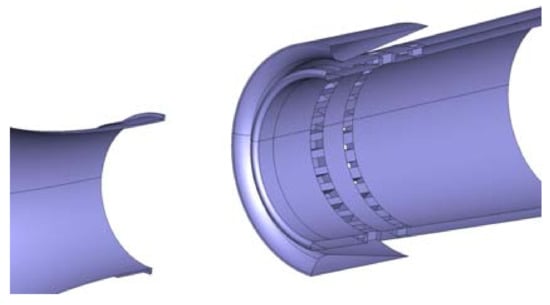
Figure 13.
Ventilation holes on the collector; the collector is split from the center for easy viewing.
3.2.2. Shape Optimization
Lacey [17,56,57] designed an inclined collector in which the front of the collector is tilted at an angle (see Figure 14). Lacey hypothesized that the distance between the nozzle and the front of the collector varies with height, resulting in significant attenuation of any single feedback frequency [56].
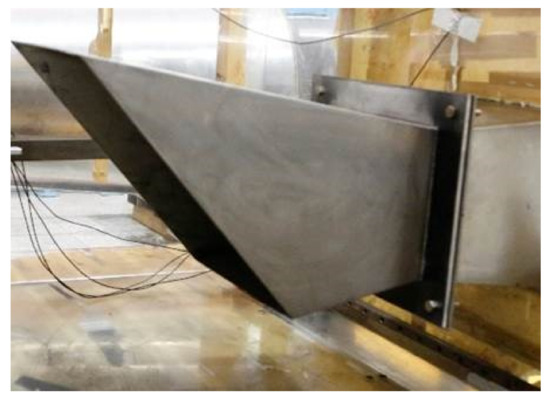
Figure 14.
Inclined collector.
Jin et al. [49] demonstrated that increasing the inlet width of the collector to fully envelop the jet shear layer can effectively mitigate low-frequency pressure fluctuations caused by standing waves in the width direction of the plenum, based on experiments conducted using the SKLA-01 scaled wind tunnel. The test results showed that widening the collector reduced the amplitude of the low-frequency pressure fluctuation by more than 50%.
The study conducted by Wang et al. [31] also demonstrated that the reduction of low-frequency pressure fluctuations can be effectively achieved by increasing the opening area through adjustments to the side and top walls of the collector in a scaled automotive wind tunnel.
Overall, properly optimized collectors can effectively reduce low-frequency pressure fluctuations in open-jet wind tunnels. However, since the configuration of the collector affects the pressure distribution in the test area, the optimization of the collector often requires multiple experiments for comparative analysis, and finding the collector configuration with good flow-field quality as well as sufficient pressure oscillation reduction can be quite demanding.
3.3. Other Passive Control Methods
In addition to the aforementioned passive control methods, commonly used techniques include the use of Helmholtz resonators to suppress specific frequencies in the plenum or pipeline circuit [31,55,60], as well as modifications to the wind tunnel pipeline to suppress the circuit standing wave frequency [9,11].
A Helmholtz resonator is a cavity that can be connected to a wind tunnel through a small tube. When the air column in the tube vibrates under the excitation of an external sound wave, a damped air spring system is formed due to friction. When the frequency of the incident sound wave matches the natural frequency of the resonator, the air column will resonate and vibrate violently, leading to the maximum consumption of sound energy, equivalent to the absorption of the sound wave by the resonator.
When FKFS upgraded the full-scale aeroacoustic wind tunnel at the University of Stuttgart, Germany, in 2014, they installed a Helmholtz resonator adjacent to the plenum [55]. By precisely tuning the resonator frequency to suppress the Helmholtz frequency of the plenum and implementing the FKFS besst vortex generators at the nozzle, they were able to achieve pulsating pressure RMS levels below 0.5% of the dynamic pressure over the entire velocity range [55].
Wang et al. [31] integrated a Helmholtz resonator into a scaled wind tunnel and adjusted its resonant frequency to match the frequency of the observed significant low-frequency pressure fluctuation in the wind tunnel. In addition, they introduced an auxiliary pipeline to the side wall of the collector, which was open upstream, closed downstream, and connected to the collector through an opening in its side wall. By carefully sizing this pipeline, the pulsating pressure within the collector could be balanced by the pulsating pressure output from the pipeline at a specific frequency band. These measures effectively reduced the low-frequency pressure fluctuations but resulted in a slight increase in noise in other frequency bands.
Kharazi et al. [60] successfully suppressed the low-frequency pressure fluctuations by using Helmholtz resonators in two BMW AVZ wind tunnels; the Helmholtz resonators also improved the pressure gradient in the test section.
The suppression measures of the low-frequency pressure fluctuations in a 3/4-scale open-jet model wind tunnel at Mitsubishi Heavy Industries were introduced by Kudo et al. [11]. They discovered that the propagation of the low-frequency pulsation in the wind tunnel was mainly in the circuit. By taking in airflow through entrainment inlets on both sides of the nozzle and expelling airflow through entrainment outlets located before and after the first corner, an effective reduction of the low-frequency pressure fluctuation was achieved.
During the acoustic upgrade in 2009, the DNW-NWB wind tunnel in Germany implemented a sudden change in the cross-sectional area between the cooling and driving sections of its pipeline. This alteration created an acoustic impedance that effectively suppressed low-frequency pressure fluctuations by preventing edgetone feedback from exciting the resonance mode of the wind tunnel circuit [9].
Stüber et al. proposed in their patent that the addition of apertures covered by elastic membranes to wind tunnel pipelines can shift the circuit resonance to a higher frequency (see [19]).
3.4. Active Control Methods
The active control method for low-frequency pressure fluctuations in open-jet wind tunnels typically involves the use of loudspeakers and movable flaps to inject energy into the flow field, thereby controlling the vortex structure and altering the frequency and intensity of the edgetone feedback. Alternatively, anti-phase sound waves emitted by loudspeakers can be used directly to eliminate pressure pulsations at specific frequencies [19,27].
The literature [26,32] presented an active control system known as ARC (Active Resonance Control), which consists of a plenum-mounted microphone to capture pressure pulsations, a wall-mounted loudspeaker on the wind tunnel circuit, and a signal conditioner to adjust the phase relationship between the microphone signal and the loudspeaker output. Experimental evaluations conducted in both the Audi aeroacoustic wind tunnel and its scaled wind tunnel in Germany showed that the ARC system effectively eliminated low-frequency pulsations caused by pipe resonances without introducing additional noise into the wind tunnel. However, it should be noted that this system is expensive and requires a sophisticated control scheme [32].
Von Heesen et al. [19] proposed an active flow control method that incorporated electrically driven movable flaps (FKFS flaps) at the nozzle of the IVK-MWT wind tunnel. By inducing forced perturbations in the shear layer at a frequency different from acoustic resonance, these movable flaps prevented vortex shedding from synchronizing with acoustic resonance, resulting in a reduction of the pressure pulsation amplitude from 134 dB to 108 dB.
Jia et al. [27] investigated the control of low-frequency pressure fluctuations using synthetic jet exciters in a 3/4-scale open-jet wind tunnel at the Shanghai Automotive Wind Tunnel Center. The synthetic jet exciter consisted of loudspeakers arranged around the nozzle. It was observed that a certain excitation frequency can effectively suppress the low-frequency pressure fluctuations, and when the excitation frequency was close to the edgetone frequency, it led to a strong amplification of the pressure oscillation.
Hu et al. [50] used numerical methods to study the so-called “flow-follow device”, which injects air flow around the nozzle. The results showed that the technique can change the feedback frequency of the edgetone, thereby preventing resonance between the edgetone and the standing wave mode in the wind tunnel loop, ultimately reducing low-frequency pressure fluctuations.
4. Concluding Remarks
The open-jet wind tunnel is a widely used form of wind tunnel configuration, and the occurrence of low-frequency pressure fluctuations is relatively common in this type of wind tunnel. Low-frequency pressure fluctuations have been extensively documented worldwide in various sizes of open-jet wind tunnels.
- Mechanism
The jet impinges on the collector, creating an edgetone feedback loop that serves as the primary source of low-frequency pressure fluctuations in open-jet wind tunnels. The occurrence of significant low-frequency pressure fluctuations is observed when the frequency of certain modes in the wind tunnel is close to the frequency of the edgetone feedback loop. The wind tunnel circuit standing wave and the plenum Helmholtz mode are widely reported as the two most common sources of excitation. More recently, planar standing wave modes in the plenum have been identified as a source of excitation. The authors contend that past studies may have underestimated the possibility of low-frequency pressure fluctuations due to planar standing waves in a plenum.
In addition to resonance with edgetone feedback, if the frequencies of two passive modes are close enough to meet the resonance conditions, these two modes might also produce significant low-frequency pressure fluctuations through self-excitation.
- Control methods
Passive control methods are efficient and cost-effective, making them the most widely used low-frequency pressure fluctuation control techniques. In contrast, active control methods, while effective, require complex control schemes to achieve the desired results and are rarely used in large wind tunnels.
A variety of low-frequency pressure fluctuation control techniques are commonly employed at two key locations where edgetone feedback occurs: the nozzle and the collector. The goal of these measures is to either attenuate the edgetone feedback to some degree or change its frequency to avoid resonance with the inherent modes of the wind tunnel. Incorporating vortex generators into the jet nozzle is a cost-effective control approach, although it does introduce broadband noise. Compared to two-dimensional sheet spoilers, three-dimensional vortex generators can partially mitigate the introduced broadband noise. The implementation of a breathing gap serves as a widely used optimization measure for collectors, and this method needs to be introduced at the design stage. In addition, the optimization of the collector shape is effective in some cases, but the selection of the optimized shape requires trial and error and is expensive.
When a standing wave is excited in the transverse or vertical direction of the plenum, increasing the size of the collector inlet to fully enclose the jet appears to be an effective means of controlling significant low-frequency pressure fluctuations. However, widening the collector may not always be a practical option for large open-jet wind tunnels in operation. In such cases, the use of CVG can reduce the jet expansion angle to some extent and achieve similar results to widening the collector. The ability of CVG to control jet development by adjusting their expansion angle may also prove useful in jet situations other than open-jet wind tunnels.
By adjusting their size, Helmholtz resonators are capable of suppressing pressure oscillations at specific frequencies in the plenum and pipe loop. Once the wind tunnel is in operation, the cost of applying this measure is relatively high. By reserving adjustable Helmholtz resonators at certain key locations in the wind tunnel pipe loop, such as near the collector and diffusers, these resonators can be adjusted after the wind tunnel is in operation to suppress pressure pulsations at specific frequencies.
- Unsolved problems
As the primary excitation source for low-frequency pressure fluctuations in open-jet wind tunnels, the general framework of edgetone feedback is well established. However, there remains some ambiguity as to how exactly the pressure wave affects the formation of coherent vortex structures in the shear layer. Therefore, it would be helpful to study the complex interaction between pressure waves and shear layers to develop a more accurate model for predicting the edgetone feedback. This is also important for understanding other types of jet impingement phenomena.
Standing waves were observed in three directions of the plenum in the SKLA-01 wind tunnel, with both longitudinal and transverse standing waves reaching resonance conditions with edgetone feedback. It is unclear whether the appearance of the longitudinal standing waves is due to resonance with edgetone feedback or self-excitation with transverse standing waves, or a combination of both.
When the standing wave is excited in the transverse direction of the plenum, the installation of a floor in the open-jet wind tunnel test section significantly increases the intensity of the low-frequency pressure fluctuation. What is the mechanism? How can it be controlled?
Author Contributions
Conceptualization, L.J. and X.B.D.; investigation, L.J., X.B.D. and J.Z.; writing—original draft preparation, L.J. and X.B.D.; writing—review and editing, L.J. and X.B.D.; visualization, J.Z. and W.Z.; project administration, X.W. All authors have read and agreed to the published version of the manuscript.
Funding
This research received no external funding.
Institutional Review Board Statement
Not applicable.
Informed Consent Statement
Not applicable.
Data Availability Statement
The study generated and analyzed a limited amount of new data, and the corresponding author can provide access to the data upon request.
Conflicts of Interest
The authors declare no conflict of interest.
Abbreviations
The following abbreviations are used in this manuscript:
| AAWT | Audi Aeroacoustic Wind Tunnel |
| ARC | Active Resonance Control |
| BMW AVZ | Aerodynamic Test Center of Bavarian Motor Works |
| CVG | Corner Vortex Generator |
| DNW-LLF | Large Low-Speed Facility of the German–Dutch Wind Tunnels |
| DNW-NWB | Low-Speed Wind Tunnel Braunschweig of the German–Dutch Wind Tunnels |
| FKFS | Institute of Automotive Engineering and Vehicle Engines Stuttgart |
| IVK-MWT | the IVK 1:4-scale Model Wind Tunnel in Stuttgart |
| LAWT | Large Acoustic Wind Tunnel |
| HAWT | Hyundai Motor Aeroacoustic Wind Tunnel |
| NASA | National Aeronautics and Space Administration |
| NRC/IAR | Institute for Aerospace Research of the National Research Council of Canada |
| RMS | Root Mean Square |
References
- Barlow, J.B.; Rae, W.H.; Pope, A. Low-Speed Wind Tunnel Testing, 3rd ed.; John Wiley & Sons: New York, NY, USA, 1999. [Google Scholar]
- Bergmann, A. The Aeroacoustic Wind Tunnel DNW-NWB. In Proceedings of the 18th AIAA/CEAS Aeroacoustics Conference (33rd AIAA Aeroacoustics Conference), Colorado Springs, CO, USA, 4–6 June 2012. Technical Report AIAA 2012-2173. [Google Scholar]
- Ciobaca, V.; Melber-Wilkending, S.; Wichmann, G.; Bergmann, A.; Küpper, A. Experimental and Numerical Studies of the Low Speed Wind Tunnel DNW-NWB’s Open Test Section Towards an Aeroacoustic Facility. In Proceedings of the 18th AIAA/CEAS Aeroacoustics Conference (33rd AIAA Aeroacoustics Conference), Colorado Springs, CO, USA, 4–6 June 2012. Technical Report AIAA 2012-2174. [Google Scholar] [CrossRef]
- Holthusen, H.; Kooi, J.W. Model and Full-Scale Investigations of the Low Frequency Vibration Phenomena of the DNW Open Jet. In Proceedings of the 79th AGARD Fluid Dynamics Panel Symposium: Aerodynamics of Wind Tunnel Circuits and Their Components, Moscow, Russia, 30 September 1996; Number AGARD-CP-585. pp. 26.1–26.8. [Google Scholar]
- Jia, Q.; Zhu, Y.; Bao, D.; Rashidi, M.M.; Yang, Z. On the Low Frequency Pressure Fluctuation in a 3/4 Open Jet Automotive Wind Tunnel. J. Appl. Fluid Mech. 2019, 12, 1359–1369. [Google Scholar] [CrossRef]
- Rennie, M. Effect of Jet Length on Pressure Fluctuations in 3/4 Open-Jet Wind Tunnels. In Proceedings of the Motor Industry Research Association Vehicle Aerodynamics 2000 Symposium, Reno, NV, USA, 9–11 October 2000. [Google Scholar]
- Rennie, M.; Kim, M.S.; Lee, J.H.; Kee, J.D. Suppression of Open-Jet Pressure Fluctuations in the Hyundai Aeroacoustic Wind Tunnel. SAE Trans. 2004, 113, 404–418. [Google Scholar]
- Amandolese, X.; Vartanian, C. Reduction of 3/4 Open Jet Low-Frequency Fluctuations in the S2A Wind Tunnel. J. Wind. Eng. Ind. Aerodyn. 2010, 98, 568–574. [Google Scholar] [CrossRef]
- Pott-Pollenske, M.; von Heesen, W.; Bergmann, A. Acoustical Preexamination Work and Characterization of the Low Noise Wind Tunnel DNW-NWB. In Proceedings of the 18th AIAA/CEAS Aeroacoustics Conference (33rd AIAA Aeroacoustic Conference), Colorado Springs, CO, USA, 4–6 June 2012. Number AIAA-2012-2175. [Google Scholar] [CrossRef]
- Chong, T.; Joseph, P.; Davies, P. Design and Performance of an Open Jet Wind Tunnel for Aero-Acoustic Measurement. Appl. Acoust. 2009, 70, 605–614. [Google Scholar] [CrossRef]
- Kudo, T.; Komatsu, Y.; Maeda, K.; Nishimura, M. Techniques for Reducing Low-Frequency Fluctuations in Aeroacoustic Wind Tunnels. J. Environ. Eng. 2009, 4, 289–301. [Google Scholar] [CrossRef]
- Jing, H.; Xia, Y.; Li, H.; Xu, Y.; Li, Y. Excitation Mechanism of Rain-Wind Induced Cable Vibration in a Wind Tunnel. J. Fluids Struct. 2017, 68, 32–47. [Google Scholar] [CrossRef]
- Zheng, Z.; Wang, Y.; Yang, Z. Buffeting Phenomenon of Open-jet Automotive Aero-acoustic Wind Tunnel. J. Tongji Univ. (Nat. Sci.) 2009, 37, 253–257. (In Chinese) [Google Scholar]
- Zheng, Z.; Wang, Y.; Yang, Z. A Study on the Mechanism of Buffeting Suppression of the Gap at Collector Throat in Automotive Wind Tunnel. Automot. Eng. 2008, 30, 804–807. (In Chinese) [Google Scholar]
- Zheng, Z.; Wang, Y.; Yang, Z. An Experimental Study on the Suppression of the Low Frequency Pulsation of Model Wind Tunnel. Automot. Eng. 2007, 29, 369–371. (In Chinese) [Google Scholar]
- Sellers, W.L.I.; Applin, Z.T.; Molloy, J.K. Effect of Jet Exit Vanes on Flow Pulsations in an Open-Jet Wind Tunnel; Technical Report NASA-TM-86299; Langley Research Center: Hampton, VA, USA, 1985.
- Lacey, J. A Study of the Pulsations in a 3/4 Open Jet Wind Tunnel; Technical Report SAE 2002-01-0251; SAE 2002 World Congress & Exhibition: Detroit, MI, USA, 2002. [Google Scholar] [CrossRef]
- Arnette, S.A.; Buchanan, T.D.; Zabat, M. On Low-Frequency Pressure Pulsations and Static Pressure Distribution in Open Jet Automotive Wind Tunnels; SAE Technical Paper 1999-01-0813; International Congress & Exposition; SAE International: Warrendale, PA, USA, 1999. [Google Scholar] [CrossRef]
- Von Heesen, W.; Höpfer, M. Suppression of Wind Tunnel Buffeting by Active Flow Control. SAE Trans. 2004, 113, 431–441. [Google Scholar]
- Ahuja, K.; Massey, K.; D’Agostino, M. Flow/Acoustic Interactions in Open-Jet Wind Tunnels. In Proceedings of the 3rd AIAA/CEAS Aeroacoustics Conference, Atlanta, GA, USA, 12–14 May 1997. Technical Report AIAA-97-1691-CP. [Google Scholar] [CrossRef]
- Manuel, G.S.; Molloy, J.K.; Barna, P.S. Effect of Collector Configuration on Test-Section Turbulence Levels in an Open-Jet Wind Tunnel; Technical Report NASA-TM-4333; Langley Research Center: Hampton, VA, USA, 1992.
- Jin, L.; Gu, Y.; Deng, X.B.; Sun, H.; Yue, T.; Zhang, J. Standing wave and its impact on the low-frequency pressure fluctuation in an open jet wind tunnel. J. Wind. Eng. Ind. Aerodyn. 2021, 208, 104413. [Google Scholar] [CrossRef]
- Jin, L.; Sun, H.; Jiang, Y.; Liang, Y.; Zhang, J. Suppression of low-frequency pressure pulsations in an open jet wind tunnel by corner vortex generators. AIP Adv. 2021, 11, 065306. [Google Scholar] [CrossRef]
- Zhang, J.; Zhao, K.; Jin, L.; Zhang, R.; Ma, R.; Li, J. Low-frequency fluctuations and their suppression in the 5.5 m × 4 m aeroacoustic wind tunnel at CARDC. Appl. Acoust. 2021, 180, 108113. [Google Scholar] [CrossRef]
- Jin, L.; Deng, X.B.; Wang, X.; Gu, Y.; Liang, Y.; Lian, Z. Standing waves in the plenum of an open jet wind tunnel: Resonance and self-excited oscillation. AIP Adv. 2022, 12, 025105. [Google Scholar] [CrossRef]
- Wickern, G.; von Heesen, W.; Wallmann, S. Wind Tunnel Pulsations and their Active Suppression. SAE Trans. 2000, 109, 1403–1416. [Google Scholar]
- Jia, Q.; Huang, L.; Zhu, Y.; Rashidi, M.; Xu, J.; Yang, Z. Experimental research of active control optimization on a 3/4 open-jet wind tunnel’s jet section. Alex. Eng. J. 2021, 60, 2265–2278. [Google Scholar] [CrossRef]
- Rockwell, D.; Naudascher, E. Self-Sustained Oscillations of Impinging Free Shear Layers. Annu. Rev. Fluid Mech. 1979, 11, 67–94. [Google Scholar] [CrossRef]
- Rockwell, D. Oscillations of Impinging Shear Layers. AIAA J. 1983, 21, 645–664. [Google Scholar] [CrossRef]
- Rossiter, J.E. Wind-Tunnel Experiments on the Flow over Rectangular Cavities at Subsonic and Transsonic Speeds; RAE Technical Report No. 64037; Royal Aircraft Establishment RAE: Farnborough, UK, 1964. [Google Scholar]
- Wang, Y.; Yang, Z.; Li, Q. Methods to Control Low Frequency Pulsation in Open-Jet Wind Tunnel. Appl. Acoust. 2012, 73, 666–672. [Google Scholar] [CrossRef]
- Evert, F.; Miehling, H. Active Suppression of Buffeting at the Audi AAWT: Operational Experiences and Enhancements of the Control Scheme. SAE Trans. 2004, 113, 419–430. [Google Scholar]
- Drazin, P.G. Introduction to Hydrodynamic Stability; Cambridge University Press: Cambridge, UK, 2002. [Google Scholar]
- Sun, M.; Liang, J.; Wang, Z. Numerical Study on Self-sustained Oscillation in Cavity Flameholders of Scramjets. Chin. J. Comput. Phys. 2007, 24, 591–597. [Google Scholar] [CrossRef]
- Powell, A. On edge tones and associated phenomena. Acta Acust. United Acust. 1953, 3, 233–243. [Google Scholar]
- Powell, A. On the Edgetone. J. Acoust. Soc. Am. 1961, 33, 395–409. [Google Scholar] [CrossRef]
- Chanaud, R.C.; Powell, A. Some Experiments Concerning the Hole and Ring Tone. J. Acoust. Soc. Am. 1965, 37, 902–911. [Google Scholar] [CrossRef]
- Brackenridge, J. Self-Maintained Transverse Oscillations of a Jet; Edge Tones. J. Acoust. Soc. Am. 1959, 31, 114. [Google Scholar] [CrossRef]
- Rockwell, D. Transverse Oscillations of a Jet in a Jet-Splitter System. J. Basic Eng. 1972, 94, 675–681. [Google Scholar] [CrossRef]
- Lepicovsky, J.; Ahuja, K.K. Some new results on edge-tone oscillations in high-speed subsonic jets. In Proceedings of the AIAA 8th Aeroacoustics Conference, Atlanta, GA, USA, 11–13 April 1983. Number AIAA-83-0665. [Google Scholar] [CrossRef]
- Lin, J.C.; Rockwell, D. Oscillations of a Turbulent Jet Incident Upon an Edge. J. Fluids Struct. 2001, 15, 791–829. [Google Scholar] [CrossRef]
- Curle, N. The Mechanics of Edge-Tones. Proc. R. Soc. Lond. Ser. A Math. Phys. Sci. 1953, 216, 412–424. [Google Scholar]
- Curle, N. The Influence of Solid Boundaries Upon Aerodynamic Sound. Proc. R. Soc. A Math. Phys. Eng. Sci. 1955, 231, 505–514. [Google Scholar] [CrossRef]
- Nyborg, W.L. Self-Maintained Oscillations of the Jet in a Jet-Edge System. I. J. Acoust. Soc. Am. 1954, 26, 174–182. [Google Scholar] [CrossRef]
- Brown, G.B. The mechanism of edge-tone production. Proc. Phys. Soc. 1937, 49, 508–521. [Google Scholar] [CrossRef]
- Stegen, G.; Karamcheti, K. Multiple tone operation of edgetones. J. Sound Vib. 1970, 12, 281–284. [Google Scholar] [CrossRef]
- Holger, D.K.; Wilson, T.A.; Beavers, G.S. Fluid mechanics of the edgetone. J. Acoust. Soc. Am. 1977, 62, 1116–1128. [Google Scholar] [CrossRef]
- Lighthill, M. On Sound Generated Aerodynamically. I. General Theory. Proc. R. Soc. A Math. Phys. Eng. Sci. 1952, 211, 564–587. [Google Scholar] [CrossRef]
- Jin, L. Research on the Mechanism and Suppression Methods of Low-Frequency Pressure flUctuations in Open Jet Wind Tunnels. Ph.D. Thesis, Nanjing University of Aeronautics and Astronautics, Nanjing, China, 2022. (In Chinese). [Google Scholar]
- Hu, X.; Luo, Y.; Leng, J.; Guo, P.; Yu, T.; Wang, J. The low frequency pressure pulsation and control of the open-jet wind tunnel. Sci. Rep. 2022, 12, 19090. [Google Scholar] [CrossRef] [PubMed]
- Hoad, D.R.; Martin, R.M. Background Noise Measurements from Jet Exit Vanes Designed to Reduce Flow Pulsations in an Open-Jet Wind Tunnel; Technical Report NASA TM-86383; NASA: Hampton, VA, USA, 1985.
- Maruta, Y.; Minorikawa, G.; Maruta, Y.; Minorikawa, G. Developments of Low-Noise Contractive Nozzle Used in Acoustic Wind-Tunnel. In Proceedings of the 3rd AIAA/CEAS Aeroacoustics Conference, Atlanta, GA, USA, 12–14 May 1997. Technical Report AIAA-97-1679-CP. [Google Scholar] [CrossRef]
- Bao, D.; Jia, Q.; Yang, Z. Effect of Vortex Generator on Flow-Field Quality in 3/4 Open Jet Automotive Wind Tunnel. SAE Int. J. Passeng. Cars-Mech. Syst. 2017, 10, 224–234. [Google Scholar] [CrossRef]
- Blumrich, R.; Widdecke, N.; Wiedemann, J.; Michelbach, A.; Wittmeier, F.; Beland, O. New FKFS Technology at the Full-Scale Aeroacoustic Wind Tunnel of University of Stuttgart. SAE Int. J. Passeng. Cars-Mech. Syst. 2015, 8, 294–305. [Google Scholar] [CrossRef]
- Michelbach, A.; Blumrich, R. Upgrade of the full-scale aeroacoustic wind tunnel of Stuttgart University by FKFS. In 15. Internationales Stuttgarter Symposium; Springer Fachmedien Wiesbaden: Wiesbaden, Germany, 2015; pp. 497–523. [Google Scholar] [CrossRef]
- Lacey, J. Concept for Reducing the Cost of Subsonic Wind Tunnels. In Proceedings of the USAF Developmental Test and Evaluation Summit, Woodland Hills, CA, USA, 14–16 November 2004. Technical Report AIAA 2004-6828. [Google Scholar] [CrossRef]
- Lacey, J. Further Tests of a Non-Resonant Configuration: SAE 2003 World Congress & Exhibition; SAE International: Detroit, MI, USA, 2003. [Google Scholar] [CrossRef]
- Hanson, C.E. The Design, Development and Construction of a Low-Noise, Low-Turbulence Wind Tunnel. Master’s Thesis, Massachusetts Institute of Technology, Cambridge, MA, USA, 1967. [Google Scholar]
- Jin, L.; Jiang, X.; Liu, Z.; Deng, X.B. Study on the mechanism impact of through-hole in collector wall on the low frequency oscillation on the wind tunnel FL-14. In Proceedings of the 8th National Conference on Fluid Mechanics, Lanzhou, China, 18–21 September 2014. (In Chinese). [Google Scholar]
- Kharazi, A.; Duell, E.; Walter, J. Application of Helmholtz Resonators in Open Jet Wind Tunnels. SAE Int. J. Passeng. Cars-Mech. Syst. 2013, 6, 436–447. [Google Scholar] [CrossRef]
- Martin, R.M.; Brooks, T.F.; Hoad, D.R. Reduction of background noise induced by wind tunnel jet exit vanes. AIAA J. 1985, 23, 1631–1632. [Google Scholar] [CrossRef]
- Paterson, R.W.; Vogt, P.G.; Foley, W.M. Design and Development of the United Aircraft Research Laboratories Acoustic Research Tunnel. J. Aircr. 1973, 10, 427–433. [Google Scholar] [CrossRef]
- Jacobs, E.N. Investigation of Air Flow in Open-Throat Wind Tunnels; Technical Report NACA Rep.322; NASA: Langley Field, VA, USA, 1929.
Disclaimer/Publisher’s Note: The statements, opinions and data contained in all publications are solely those of the individual author(s) and contributor(s) and not of MDPI and/or the editor(s). MDPI and/or the editor(s) disclaim responsibility for any injury to people or property resulting from any ideas, methods, instructions or products referred to in the content. |
© 2023 by the authors. Licensee MDPI, Basel, Switzerland. This article is an open access article distributed under the terms and conditions of the Creative Commons Attribution (CC BY) license (https://creativecommons.org/licenses/by/4.0/).